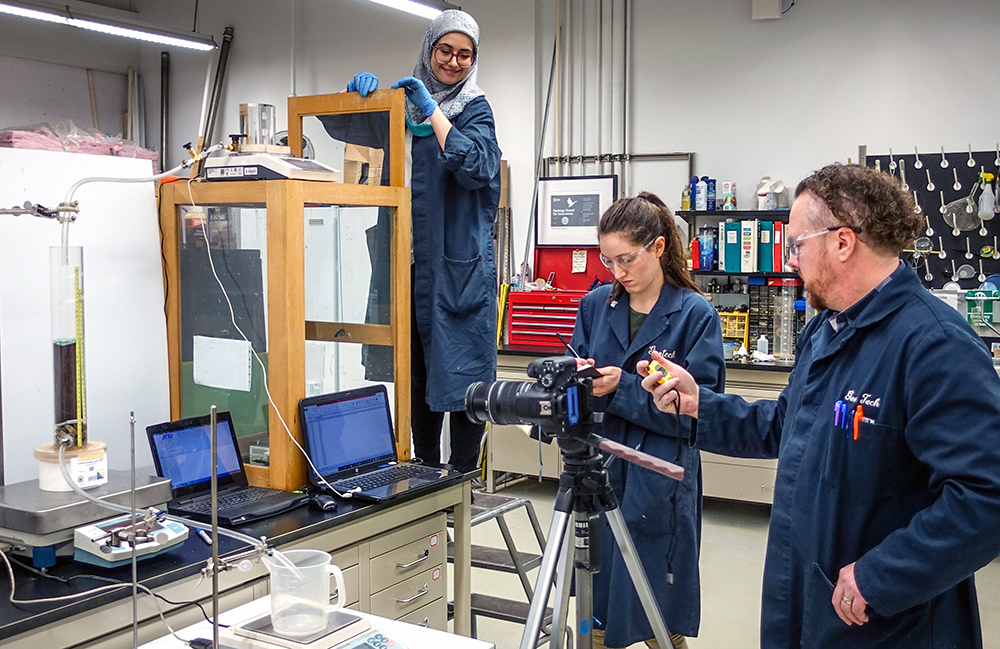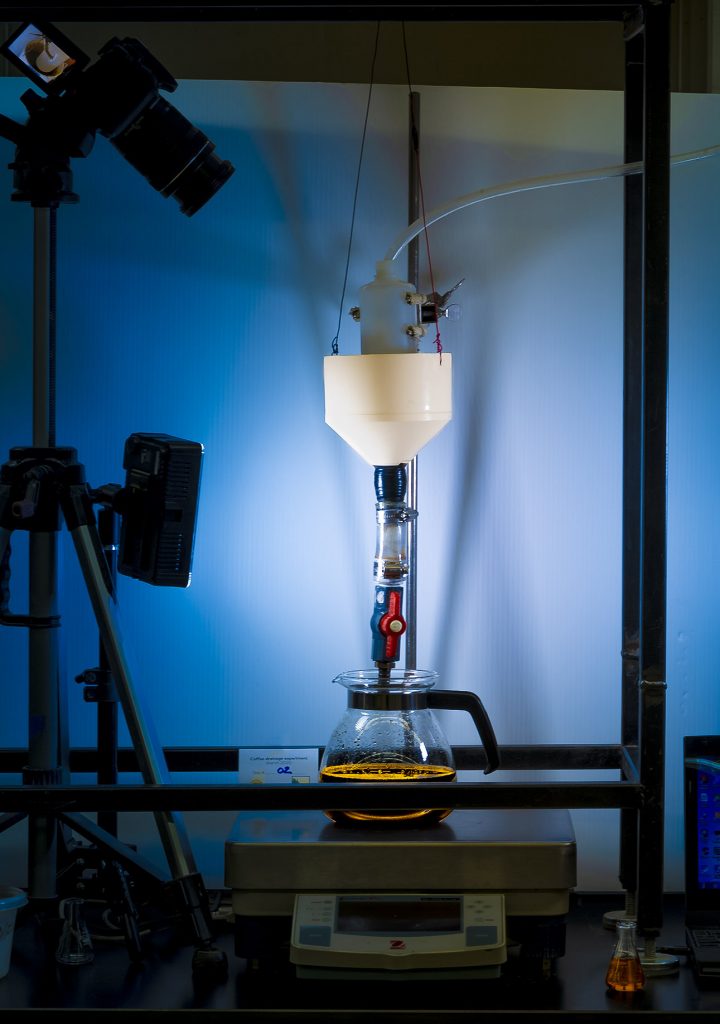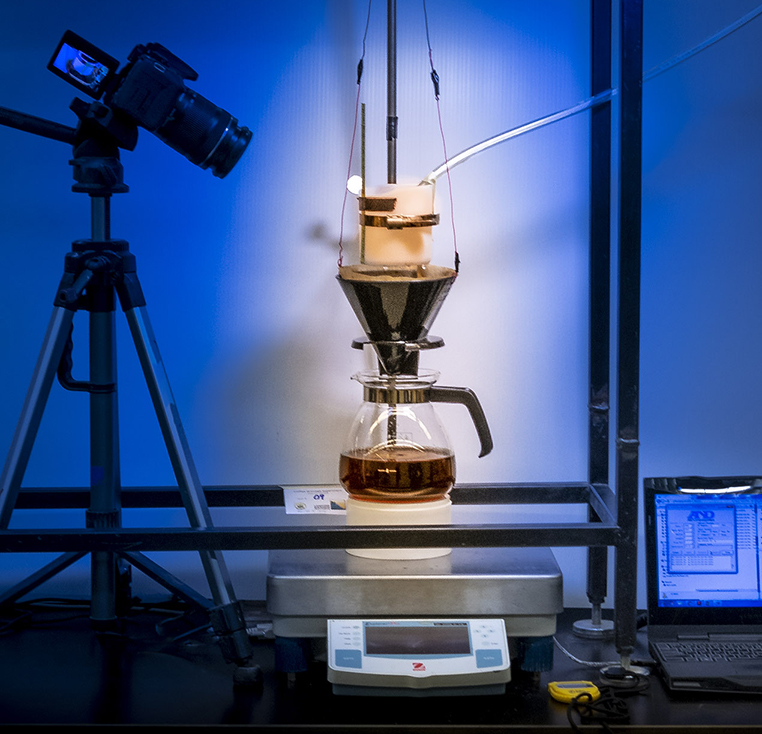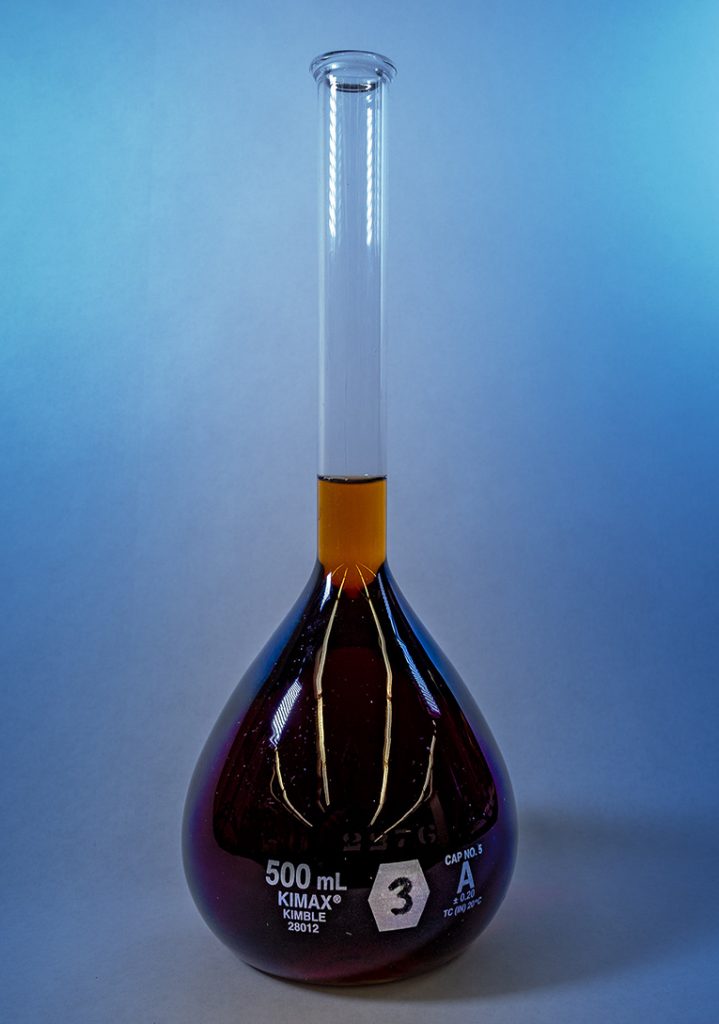
THE GREAT GEOTECHNICAL DRIP-COFFEE EXPERIMENT
Gord McKenna, principal of McKenna Geotechnical Inc, had the pleasure of working with a team at the University of Alberta on a unique “geotechnical drip-coffee” experiment to demonstrate water flow in the unsaturated zone to mimic cover systems and waste rock and tailings profiles. The team included Prof. Nick Beier (pictured below at right), research associate Ahlam Abdulnabi (top), and co-op student Abby Paul.

PURPOSE: To demonstrate the wetting-up and drawing-down mechanics of cover systems and mine-waste profiles using a drip-coffee setup, how to conduct a mass balance, and the results of applying standard geotechnical test methods to a familiar granular food product. Based on previous experience testing and comparing the geotechnical properties of foods such as porridge, yogurt, pie filling, and chocolate milk with those of soft tailings (McKenna et al. 2018), the drip-coffee process is demonstrably similar to the flow of precipitation water through mine waste.
BACKGROUND: Beier and McKenna worked with Abdulnabi and Paul in a University of Alberta laboratory from March 2 to 6. The team spent three days collecting 50,000 datapoints over 28 trials using 12 different coffee grinds (from whole beans to Turkish grind). After a month of preparation, they spent a day perfecting the system, a day experimenting, and another day working through the grinds. The project’s working title is Demonstration of water infiltration into mine waste – the “Geotechnical Drip-Coffee Experiment.”
Step. 1: Clean, cold tap water comes in from a reservoir at the upper right through a hose that empties into a white Buchner funnel with a basket coffee filter and 50 g of Folgers ground coffee inside. The coffee in the funnel wets up, then drips out the bottom into the pot, which is sitting on a scale. The mass of the reservoir, the funnel system, and the coffee pot are measured every second throughout each 10-minute brew test. The funnel never allowed all the coffee grounds to saturate; most stayed dry, and in landform cover systems this is called “preferential flow.” The mass measurements and flow rates were captured successfully, but it was back to the drawing board as the experiment failed to meet the original purpose.

Step 2: The team then replaced the Buchner funnel with a Melita coffee cone and a #6 filter. The small hole in the bottom of the cone restricted the flow and caused the coffee grinds to flood soon after water delivery began. Everything else was the same as in Step 1. But this restricted flow caused by the cone did not mimic the flow mechanisms in a cover. While interesting and visually compelling, the result was far from a clear geotechnical demonstration.

Step 3: The team switched to a tall column and used more coffee. This setup more closely replicated the behaviour of a cover on a waste rock dump or the top of a tailings pond profile. The cylinder has some gravel in the bottom to permit drainage, and being clear, it allowed the researchers to record what was happening as the water flowed through the coffee. High-permittivity geotextile filters were used to prevent scour erosion of the influent water and prevent piping of the effluent coffee into the gravel drain. A dry mass of coffee was poured into the tube forming a loose deposit. During the percolation test, weights were recorded every second, and the stopwatch was started when the water began to flow onto the ground coffee in the cylinder. Visual observations were quickly recorded and each test was captured by video. Before-and-after samples of coffee grounds were taken and oven dried in a 60 °C oven to determine gravimetric moistures to be used in the mass balance. The team used this approach to test all the grinds, and a few layered systems, too.
The team has started processing the data from 28 trials and some early results are already available: The data collected proved successful for demonstrating the wetting-up and drawing-down of the water table in the coffee. The graph below shows one set of early results. The second-by-second mass balance (Qin + Qchange in storage + Qout = 0) seems to be working, although a correction for the mass of water in the tubing will need to be made, something we had hoped could be neglected. The visual observations of the coffee wetting up and drawing down and the propensity for preferential flow in the cylinder will be useful for teaching all on their own.

The experiment produced two disappointments. First, initial dry-sieve grain-size testing of the coffee suffered from clumping of the finer grinds, so wet-sieve tests are planned for all samples when the lab reopens. Second, the measured specific gravity from the 500 mL volumetric flask showed coffee density was indistinguishable from tap-water density (essentially 1.00 g/mL), and therefore was not that useful for mass balance measurements in terms of estimating extractible oils.

The Dean Stark extraction test (1920) used for oil sands tailings bitumen contents (among many other things) would have been more appropriate. The team will be interested to see how the measured soil-water characteristic curves match those from empirical curve-fitting to the wet-sieve grain sizes. How the field capacity moisture contents plot against the grain-size curves, and the influence of coffee grain-size distribution on hydraulic conductivity using both constant-head and falling-head tests are also worth further study, as are the loose densities and the maximum standard Proctor density of regular drip coffee.
Stay tuned.
McKenna G, Mann V, Fisseha B, Beier N, and Olmedo N. 2016. The geotechnical vane strength of soft tailings compared to soft foods. Fifth International Oil Sands Tailings Conference, December 4-7. Lake Louise, Alberta. University of Alberta Geotechnical Group, Edmonton. 11 pp.
Dean EW and Stark DD. 1920. A convenient method for the determination of water in petroleum and other organic emulsions. The Journal of Industrial & Engineering Chemistry. 12 (5): 486–490.
